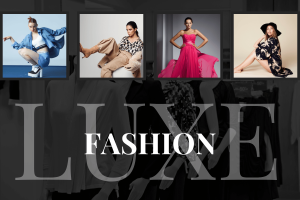

Luxe fashion, short for luxury fashion, is a realm of style that transcends mere clothing; it’s an expression of opulence, craftsmanship, and exclusivity. This segment of the fashion industry caters to individuals who seek more than just attire—they desire an experience, a statement, and a symbol of prestige.
In this exploration of luxe fashion, we delve into the origins, defining characteristics, and the evolving landscape of this captivating world where exquisite design meets unparalleled craftsmanship.
Table of Contents
The roots of luxe fashion can be traced back centuries, where craftsmanship and exclusivity were valued by royal courts and the aristocracy. High-quality materials, intricate detailing, and bespoke tailoring defined clothing for the elite.
Over time, luxury fashion houses emerged, each with its unique style and heritage, further solidifying the concept of luxe fashion. Paris, the fashion capital of the world, has played a pivotal role in shaping luxe fashion.
Established names such as Chanel, Louis Vuitton, and Christian Dior have become synonymous with luxury, creating timeless pieces that stand as testaments to the enduring allure of opulence.
Luxe fashion distinguishes itself through several key characteristics, each contributing to its unparalleled appeal:
Luxe fashion is a celebration of artistry and meticulous craftsmanship. Each garment is a masterpiece, created by skilled artisans who devote countless hours to perfecting their craft. From hand-stitched embroidery to precision tailoring, every detail reflects a commitment to excellence.
The use of exquisite materials sets luxe fashion apart. From rare and ethically sourced fabrics to luxurious leathers and embellishments, the emphasis is on quality rather than quantity. These materials not only enhance the aesthetic appeal but also contribute to the longevity of the garment.
One of the hallmarks of luxe fashion is exclusivity. Limited edition releases and bespoke creations ensure that only a select few can possess these coveted pieces. This exclusivity adds an element of prestige, turning fashion into a form of art collecting.
Luxury fashion houses often boast iconic logos and branding that serve as status symbols. The interlocking Cs of Chanel, the monogram of Louis Vuitton, and the unmistakable red soles of Christian Louboutin are not just symbols; they are emblems of a lifestyle associated with sophistication and affluence.
Luxe fashion is synonymous with attention to detail. From the cut of a garment to the placement of buttons, every element is carefully considered. This meticulous approach ensures that each piece not only looks exquisite but also feels extraordinary.
While the traditional image of luxe fashion conjures visions of haute couture and exclusive boutiques, the landscape is evolving with changing consumer preferences and the advent of digitalization.
The modern luxury consumer is more conscious of ethical practices and sustainability. Luxury brands are adapting by incorporating eco-friendly materials, ethical sourcing, and transparent supply chains. The shift towards inclusivity is also evident, with luxury houses embracing diversity in their campaigns and runway shows.
The digital era has transformed the way luxe fashion engages with consumers. Social media, e-commerce, and virtual experiences have become integral to the industry. Luxury brands are not only showcasing their collections online but also leveraging technology to enhance the shopping experience, from virtual try-ons to augmented reality fashion shows.
Collaborations between luxury brands and streetwear designers have blurred the lines between high and street fashion. This merging of styles has given rise to a new wave of luxe streetwear, appealing to a younger demographic and challenging traditional notions of luxury.
The demand for personalized and unique experiences has led to a surge in customization services offered by luxury brands. From monogrammed accessories to made-to-order garments, consumers can now tailor their purchases to reflect their individual style.
Luxe fashion appeals to a wide range of people, for a variety of reasons. For some, it is a way to express their personal style and taste. For others, it is a way to feel confident and glamorous. And for still others, it is a way to invest in their own future, as luxe fashion items can often hold their value well over time.
Luxe fashion remains a captivating realm that transcends trends and time. Rooted in a rich history of craftsmanship and exclusivity, it continues to evolve, embracing modern values of sustainability, inclusivity, and digital engagement.
As the allure of luxe fashion persists, it not only symbolizes status and affluence but also serves as a canvas for artistic expression and a celebration of the extraordinary. In the ever-changing landscape of fashion, luxe fashion stands as a testament to the enduring appeal of opulence and elegance.
The global luxe fashion market is expected to reach $322.3 billion by 2025.
The top 10 luxe fashion brands are:
Gucci, Louis Vuitton, Hermès, Chanel, Prada, Cartier, Dior, Burberry, Saint Laurent, and Versace.
The average price of a luxe fashion item is $1,000.
The most popular luxe fashion items are handbags, shoes, and jewelry.
The Dyson Airwrap revolutionized how individuals style their hair. It's the perfect blend of innovation,…
Mother's Day is the day to celebrate the amazing mothers who raised us and took…
Soap nails have been the most trending manicure style of 2025, and it has thrilled…
Ah, prom season—the one marked by sparkling gowns, immaculate tuxes, lifelong memories. But one major…
Acne can be one of the most infuriating skin issues to work with. Whether it's…
The second weekend of Coachella 2025 was a full-fledged fashion extravaganza, with celebrities descending upon…